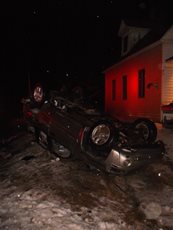
The Cost of a Marijuana Related Vehicle Accident
Tonight (March 17, 2016) the City of Presque Isle’s Planning Board meets to discuss a variety of issues surrounding the development of a new city ordinance pertaining to medical marijuana dispensaries setting up shop in Presque Isle. I have been asked to appear in order to provide an explanation of the anticipated public safety monetary costs that may be associated with a dispensary. It stands to reason that if a dispensary comes to Presque Isle, there is a greater risk of more people using marijuana in Presque Isle. It also seems reasonable to expect that more people would be driving while under the influence of marijuana, leading to additional law enforcement costs.
The supporters of the legalized marijuana movement like to argue that there are no solid numbers to support exactly how big or small the number of marijuana related intoxicated driving cases there are, which may have some merit. So the question for me this week was how to present a realistic cost to the board without sounding like I’m simply an anti-marijuana cop pulling figures out of thin air just to support my position. As luck would have it – good luck for my presentation and bad luck for the driver and occupant – we had a serious accident early yesterday morning.
A nineteen year old boy, who does not have a valid driver’s license, took his mother’s SUV without permission and picked up his 15 year old friend. According to the 15 year old child, they smoked marijuana together just prior to the accident (paraphernalia supporting the child’s statement was found at the scene scattered around the SUV). Then, as they’re driving about 80 mph, he lost control of the vehicle and flipped the SUV. The good news is the 15 year old child wasn’t seriously injured; the bad news is that the driver was. His head trauma required him to be transported to the hospital.
Let’s examine the monetary costs associated with this incident, keeping in mind that the costs continue to grow. At about 12:17 a.m. on March 16th two police officers were dispatched to the above accident. Moments before, a fire department crew of two firefighters and ambulance crew of two paramedics were dispatched. The police officers pay rates are $18.91 and $19.56 per hour; the firefighters pay rates on a 40 hour work week are $22.82, $20.49, and $17.85 per hour (of course these figures do not include the costs of fringe benefits). One of the responders is an employee of The Aroostook Medical Center and their pay rate is unknown.
The very conservative running total for this crash so far is about $548.71 to taxpayers but we haven’t even began to discuss the medical piece of this puzzle. Here are some of the costs I don’t know:
Some of the community and family related costs associated with this incident are likely to be:
I haven’t tackled the personal, non-monetary costs associated with a family coming so near to losing a child and the lingering impact of something of that sort. While most of the bulleted points are real costs, some are possible costs depending upon future events like criminal prosecution etc… It would be very easy to get into more abstract costs like diminished services to the rest of the community while these first responders were tied up with this accident, but I will refrain. What is obvious is that one crash due to the use of marijuana is unaffordable to a small community let alone the potential for the human cost.
I don’t know any police chiefs who have an interest in denying their communities additional opportunities for increased revenue or commercial vibrancy; it’s just that the legalization of marijuana does none of that. Every perceived gain is off-set by the harsh reality of unaffordable costs to communities and lives.
– Chief Irwin
This post was originally published on March 17, 2016 on Chief Irwin’s blog.